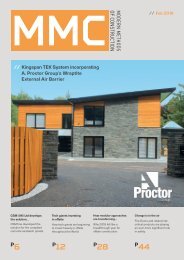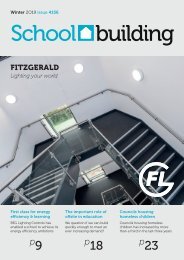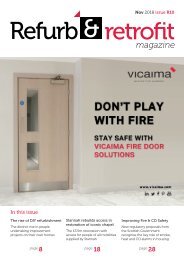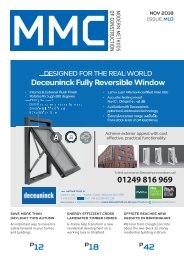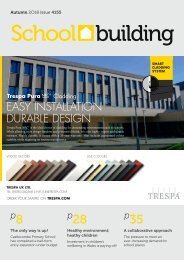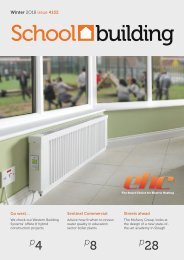R&R 8958 48 July '16 cc
Create successful ePaper yourself
Turn your PDF publications into a flip-book with our unique Google optimized e-Paper software.
CO2: Don’t be neutral, be negative!<br />
It is common knowledge that in<br />
order to effectively combat<br />
global warming, we need to<br />
make conscious efforts to<br />
reduce our carbon footprint.<br />
Given that buildings are<br />
a<strong>cc</strong>ountable for 37% of total UK<br />
greenhouse gas emissions<br />
(a<strong>cc</strong>ording to the Committee on Climate Change) we have a duty as<br />
specifiers, architects and construction professionals to lower this alarming<br />
: GaraRoll White<br />
figure. Joe Bradbury investigates.<br />
Going neutral isn’t enough<br />
Whenever CO2 reduction is discussed, we often talk about becoming<br />
carbon neutral, i.e. designing or retrofitting our building to use only as much<br />
atmospheric CO2 as it emits, leaving existing levels intact. However,<br />
approximately 30 billion metric tons of carbon dioxide is pumped into the<br />
Earth’s atmosphere from power plants, vehicles and various other industrial<br />
sources which are intensively fuelled from the burning fossil fuels. So, whilst<br />
going neutral can certainly help the problem, it’s a mere drop in the ocean in<br />
terms of fighting climate change.<br />
We therefore need to not only focus on reducing how much CO2 we<br />
produce, but also on how we can physically remove it from the air.<br />
Capturing CO2<br />
Allison Dring, head of start-up Elegant Embellishments, has designed a smogeating<br />
façade that is a perfect example of how a building can go a step<br />
further and actually become carbon negative. Described on the BBC, “The<br />
façade is coated with a special paint made from titanium dioxide, a<br />
pollution-fighting technology that is activated by daylight. It absorbs the<br />
fumes generated from traffic and converts them first into nitric acid and<br />
then into calcium nitrate, which is harmless.”<br />
The facade has currently been fitted on the side of a hospital in Mexico City,<br />
where pollution is a massive issue. Since being added to the building, the<br />
innovative façade has allegedly reduced pollution of around 1,000 cars per<br />
day, perhaps resulting in less people needing to visit the hospital in the first<br />
place!<br />
Allison is a staunch advocate of the idea that the materials we build with<br />
should actively give something back to the environment – and so am I.<br />
Putting it to good use<br />
Becoming carbon negative is a two stage process; consuming the CO2 is only<br />
the first part of the solution. What do you do with the CO2 once it has been<br />
captured from the air? Turning it into usable materials or less harmful gasses<br />
is the key to becoming truly carbon negative and actually being an asset to<br />
the environment.<br />
Atmospheric CO2 is one of the biggest issues of the 21st century… however,<br />
as the old adage “one man’s waste is another man’s treasure” implies, it is also<br />
a precious resource! We can use the CO2 taken from the air and convert it<br />
into useful carbon-based products, such as building materials,<br />
pharmaceuticals, fuels and plastics.<br />
Not only do these products help us as an industry, but the very creation of<br />
them absorbs more CO2 than we emit, ergo reducing CO2 in the<br />
atmosphere. Now THAT is a solution.<br />
So in short, when it comes to tackling climate change in the built<br />
environment, be negative!<br />
<strong>July</strong> / August 2O16 issue <strong>8958</strong> refurb| RENEW 39





